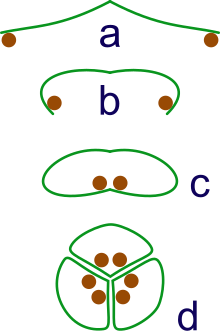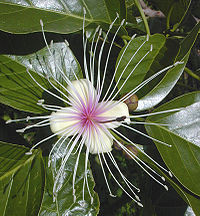Intyatyambo

intyatyambo lolunye uhlobo lwesityalo. Ngamanye amaxesha kuthiwa ziibloom okanye ziiblossom zesityalo. Isityalo sikhula kwiThe plant grow on a stalk – a thin node – which supports the flower. Flowers have petals. Inside the petals are the parts which produce seeds.
Flowers are the reproductive structure of flowering plants, which are plants of the division Magnoliophyta, also called the Angiosperms.
In many plants, a flower is its most colourful part. We say the plant 'flowers', 'is flowering' or 'is in flower' when this colourful part begins to grow bigger and open out. There are many different kinds of flowers in different areas in the world. Even in the coldest places, for example the Arctic, flowers can grow during a few months.
Flowers may grow separately on the plant, or they may grow together in an inflorescence.
Indlela ezimile ngayo iintyatyambo
[tshintsha | Yenza izilungiso kokubhaliweyo]

In botany, flowers are the key evolutionary advance made by flowering plants. To investigate the structure of a flower, it must be dissected, examined under a binocular microscope, and its structure summarised by a floral diagram or a floral formula. Then its family can be identified with the aid of a flora, which is a book designed to help you identify plants.
Flowers contain the reproductive organs of a plant. Some flowers are dependent upon the wind to move pollen between flowers of the same species. Many others rely on insects or birds to move pollen. The role of flowers is to produce seeds or fruit (fruits contain seeds). Fruits and seeds are a means of dispersal. Plants do not move, but wind, animals and birds spread the plants across the landscape.
imvelaphi yeentyatyambo
[tshintsha | Yenza izilungiso kokubhaliweyo]
a: imbewu yeziqhamo ehlala kwincakam yegqabi
b: igqabi elingamajikojiko ukubhekaphezulu ukuze likhusele imbewu yeziqhamo
c: igqabi elingamajikojiko ukuze lenze into esongeneyo nevalekileyo
d: ukuma kwalo eli gqabi lisongelene lenze amaqela amathathu eesyncarp
Iintyatyambo ngamagqabi enziwe ngokutsha aphantsi kweqela elaziwa ngokuba zii''angiosperm'', navela kade kwi- fossil record.
The flowering plants have long been assumed to have evolved from within the gymnosperms; but gymnosperms form a clade which is distinct from the angiosperms. The two clades diverging some 300 million years ago.[1]
Since the ovules are protected by carpels and integuments, it takes something special for fertilisation to happen. Angiosperms have pollen grains comprising just three cells. One cell is responsible for drilling down through the integuments, and creating a passage for the two sperm cells to flow down. The megagametophyte[2] has just seven cells; of these, one fuses with a sperm cell, forming the nucleus of the egg itself, and another other joins with the other sperm, and dedicates itself to forming a nutrient-rich endosperm. The other cells take auxiliary roles. This process of "double fertilisation" is unique and common to all angiosperms.
Flowers and flowering plants first appeared about 130 million years ago in the Lower Cretaceous.[3][4]
Flowers for people
[tshintsha | Yenza izilungiso kokubhaliweyo]As decoration
[tshintsha | Yenza izilungiso kokubhaliweyo]
Flowers have long been admired and used by humans. Most people think that flowers are beautiful. Many people also love flowers for their fragrances (scents). People enjoy seeing flowers growing in gardens. People also enjoy growing flowers in their backyards, outside their homes. People often wear flowers on their clothes or give flowers as a gift during special occasions, holidays, or rituals, such as the birth of a new baby (or a Christening), at weddings (marriages), at funerals (when a person dies). People often buy flowers from businesses called florists.
As a name
[tshintsha | Yenza izilungiso kokubhaliweyo]Some parents name their girl children after a flower. Some common flower names are: Rose, Lily, Daisy, Holly, Hyacinth, Jasmine, Blossom.
As food
[tshintsha | Yenza izilungiso kokubhaliweyo]
People also eat some types of flowers. Flower vegetables include broccoli, cauliflower and artichoke. The most expensive spice, saffron, comes from the crocus flower. Other flower spices are cloves and capers. Hops flowers are used to flavor beer. Dandelion flowers are often made into wine.
Honey is flower nectar that has been collected and processed by bees. Honey is often named for the type of flower that the bees are using (for example, clover honey). Some people put flowers from nasturtiums, chrysanthemums, or carnations in their food. Flowers can also be made into tea. Dried flowers such as chrysanthemum, rose, jasmine are used to make tea.
Special meanings
[tshintsha | Yenza izilungiso kokubhaliweyo]
Flowers were used to signal meanings in the time when social meetings between men and women was difficult. Lilies make people think of life. Red roses make people think of love, beauty, and passion. In Britain, Australia and Canada, poppies are worn on Memorial Day as a mark of respect for those who served and died in wars. Daisies make people think of children and innocence.
List of common flowers
[tshintsha | Yenza izilungiso kokubhaliweyo]- Daffodil
- Dahlia
- Daisy
- Edelweiss
- Hibiscus
- Jasmine
- Lily
- Water Lily
- Lotus
- Marigold
- Morning glory
- Pansy
- Petunia
- Tulip
- Rose
- Sunflower
Related pages
[tshintsha | Yenza izilungiso kokubhaliweyo]References
[tshintsha | Yenza izilungiso kokubhaliweyo]- ↑ Nam, J.; Depamphilis, CW; Ma, H; Nei, M (2003) "Antiquity and evolution of the MADS-Box gene family controlling flower development in plants" Mol. Biol. Evol. 20 (9): 1435–1447 PMID 12777513 doi:10.1093/molbev/msg152
- ↑ tiny haploid female plant which includes the egg.
- ↑ Crepet W.L. (2000) "Progress in understanding angiosperm history, success, and relationships: Darwin's abominably "perplexing phenomenon"" Proceedings of the National Academy of Sciences 97 (24): 12939–41 PMC 34068 PMID 11087846 doi:10.1073/pnas.97.24.12939 archived from the original on 2007-11-03 retrieved 2014-08-22
- ↑ Wilson Nichols Stewart & Gar W. Rothwell 1993Paleobotany and the evolution of plants. 2nd ed, Cambridge Univ. Press.
